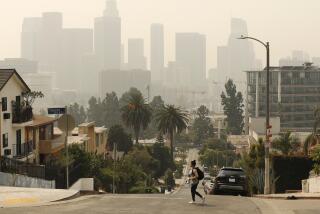EPA Officially Links Passive Smoke, Cancer : Health: The report gives nonsmokers ammunition in the fight for cleaner air. The tobacco industry objects, saying study ignored some evidence.
- Share via
WASHINGTON — In a report that it called one of the most important in its history, the Environmental Protection Agency on Thursday officially branded secondary tobacco smoke a human carcinogen, concluding that it causes 20% of all lung cancers in the United States not attributed directly to the smoking habit.
The massive study provides nonsmokers with significant new evidence to bolster demands for smoke-free air and is certain to intensify efforts to ban smoking in public places.
That pressure began immediately as the Department of Health and Human Services announced, in conjunction with the EPA report, that it will launch a multimedia campaign to spread the word about the dangers of secondhand smoke and to urge nonsmokers to stop being passive victims.
“The meaning of this report is simple and clear,” said HHS Secretary Louis W. Sullivan. “It is time for Americans who smoke to make the choice to stop smoking, and, in particular, it is irresponsible for smokers to expose young children to the health consequences of their addiction.”
As expected, the report drew strong objections from the tobacco industry, which accused the EPA of ignoring contrary evidence.
The study, based on scores of studies by scientists around the world, blamed secondary tobacco smoke for about 3,000 lung cancer deaths each year among nonsmokers in the United States and also concluded that passive smoke is responsible for:
--150,000 to 300,000 cases of respiratory infections, such as pneumonia and bronchitis, among infants and young children.
--Worsening asthmatic conditions in as many as 200,000 children.
--Possible development of asthma in children not previously afflicted.
Sullivan also noted that a study, which appeared too late to be included in the EPA analysis, by the National Center for Health Statistics found that babies are three times more likely to die of sudden infant death syndrome if their mother smoked during and after pregnancy.
The EPA declaration formally places secondary smoke in a category with benzene, radon and asbestos as a dangerous carcinogen.
EPA Administrator William K. Reilly said the finding that blames secondhand smoke for 20% of lung cancers in nonsmokers translates into a risk of about 1 in 1,000 for nonsmokers and an additional risk of 2 in 1,000 for the nonsmoking spouses of smokers.
Those risks, Reilly said, are at least 10 times greater “than they are for virtually any chemical or risk that EPA regulates.” The conclusions are expected to pressure the federal Occupational Safety and Health Administration to sharply restrict smoking in the workplace.
Reilly and Sullivan praised federal agencies, including the Veterans Administration and the Peace Corps, as well as EPA and HHS, for banning smoking in their facilities, but they stopped short of asking for a total ban in federal buildings.
They called on private businesses to assure that their customers can enjoy a smoke-free environment but did not call for outright bans in businesses such as restaurants.
While adults can make a decision on the risks of smoking, Reilly said, “I do not believe that we should have the right to subject people to risks that are involuntary.”
“Now it is time,” Sullivan said, “for our public officeholders of both parties to likewise withstand the pressure of the tobacco industry to water down or defeat anti-smoking legislation--pressure fueled by millions of dollars in political contributions and additional funds to support so-called ‘smokers’ rights campaigns.”
Anticipating the report, the Tobacco Institute, the industry’s lobbying organization, renewed charges that the EPA manipulated results and ignored significant scientific evidence pointing in directions counter to its conclusions.
More to Read
Sign up for Essential California
The most important California stories and recommendations in your inbox every morning.
You may occasionally receive promotional content from the Los Angeles Times.










